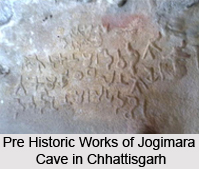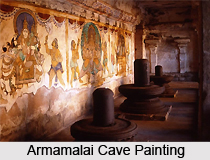 Many ancient painting in India have been preserved over time, even though painting, as an art form, is considered to be comparatively fragile and short lived. The rock cut structures and cave paintings provide the art to survive for ages. No other place on earth can compete with India in this respect. The geology of the Deccan Plateau and other region of India, offer enough domes and cliff faces suitable to rock cut caves. Since the pre-historic days India has experienced extremely flourishing and diversity of culture.
Many ancient painting in India have been preserved over time, even though painting, as an art form, is considered to be comparatively fragile and short lived. The rock cut structures and cave paintings provide the art to survive for ages. No other place on earth can compete with India in this respect. The geology of the Deccan Plateau and other region of India, offer enough domes and cliff faces suitable to rock cut caves. Since the pre-historic days India has experienced extremely flourishing and diversity of culture.
Indian Cave Paintings in Prehistoric times
Smaller shelters and natural caves in India very often contain prehistoric art and paintings. Monuments of the exceptional value are Bhimbetka Rock Shelters, here, more than 500smaller rocks and caves contains thousands of paintings. Some of the oldest paintings here are more than 15000 years old, and in some cases it is 30,000 years old. The prehistoric art from is spread all over India from snow covered Himalayas to south of Tamil Nadu.
Ancient Indian Cave Painting
s
The Cave 10 in Ajanta contains the oldest Indian paintings made circa 1st century BC. Substantive part of the Ajanta paintings is from the later time, mainly from 460 AD to 480 AD. The designs and art forms are world renowned and tell stories of the life of Buddha and other characteristic features about Buddhism. Many of the sculptures and women paintings depict mythical beings like nagas, yakshas, vrikshikas, river goddesses Yamuna and Ganga. The super natural beauty is part of the feel and essence of such beings.
The unique monument of art in India, which is also internationally famous, is found in Jogimara Cave in Chhattisgarh, made circa in the 1st century BC. Contrary to other cave paintings, here there is no depiction of Indian religion. The paintings mainly show fish, elephant figures, dancing couple and chariots.
 The Pitalkhora Caves in Maharastra were decorated with beautiful paintings in 4th century AD, and the remains of these art and paintings are preserved till today. Some of the ancient and beautiful Indian cave paintings have been carefully preserved in Bagh Caves in Madhya Pradesh. This truly beautiful artwork has been created circa 4th-6th century AD. There are paintings which have been restored in the royal Badami Cave Temple in Karnataka from 6th -7th century AD. Here the ceilings contain the painting pictures of four armed Brahma on his swans. The traces of less impressive ancient paintings from 3rd - 8th century AD are found in many caves in Maharashtra- Thanale, Karsamble, Kuda Lenvadri, Tulja Lena, Shivneri, Manmod also popular for Bhaja Caves and Elephanta Caves. The traces of ancient paintings are found in Ravana Phadi- beautiful cave temple from 550 AD in ancient capital Aihole in Karnataka.
The Pitalkhora Caves in Maharastra were decorated with beautiful paintings in 4th century AD, and the remains of these art and paintings are preserved till today. Some of the ancient and beautiful Indian cave paintings have been carefully preserved in Bagh Caves in Madhya Pradesh. This truly beautiful artwork has been created circa 4th-6th century AD. There are paintings which have been restored in the royal Badami Cave Temple in Karnataka from 6th -7th century AD. Here the ceilings contain the painting pictures of four armed Brahma on his swans. The traces of less impressive ancient paintings from 3rd - 8th century AD are found in many caves in Maharashtra- Thanale, Karsamble, Kuda Lenvadri, Tulja Lena, Shivneri, Manmod also popular for Bhaja Caves and Elephanta Caves. The traces of ancient paintings are found in Ravana Phadi- beautiful cave temple from 550 AD in ancient capital Aihole in Karnataka.
Medieval Indian Cave Paintings
The structures of Indian paintings and art forms that is comparatively less known is in Sittanavasal Cave (Tamil Nadu). In the 7th and 9th century AD there was rock cut Jain Temple named Arivar-Koil. The paintings here cover the upper part of the ceilings and were built in 9th century AD.
Armamalai Cave that was built in 8th century is a natural cave that served as Jain sanctuary.
Thirunadhikkara Cave Temple now in Tamil Nadu is a typical rock cut Jain Temple that was built in 8th century AD. The interior of the temple is decorated with beautiful paintings. Though now only hazy outlines remain, but once upon a time there were colourful depiction of the stories from Ramayana and Mahabharata. The style of the painting was later used in the Kerala style of painting.
In Olipathivishnu Vishnugraham, which was built in 9th century AD, the walls are covered with paintings and stucco. The drawing depicts ten incarnations of Vishnu- Dashavatara and also other motives of religious natures.
 There are many rock cut cave temple and also monasteries situated in Himalayan regions. Saspol Caves, located in Jammu and Kashmir, contains Buddhist panteon. Most of the paintings use blue colour and has an uncanny resemblance with Indian Buddhist art.
There are many rock cut cave temple and also monasteries situated in Himalayan regions. Saspol Caves, located in Jammu and Kashmir, contains Buddhist panteon. Most of the paintings use blue colour and has an uncanny resemblance with Indian Buddhist art.
There are also traces of beautiful wall paintings found in Tabo Caves in Himachal Pradesh and in Bhimbetka Rock in Madhya Pradesh. Significant traces of medieval paintings are also found in Thiruparankundram, Murugan Temple (Tamil Nadu), Kanheri Caves in Maharashtra, Undavalli in Andhra Pradesh and Manmod Caves in Maharashtra.





